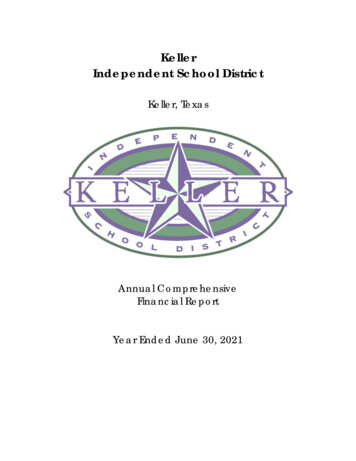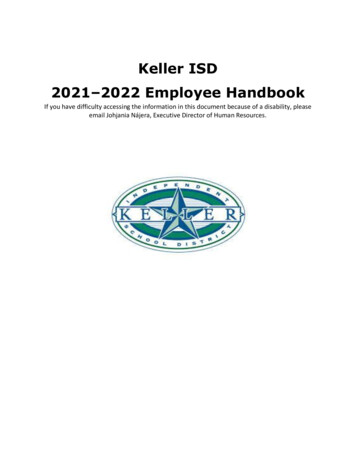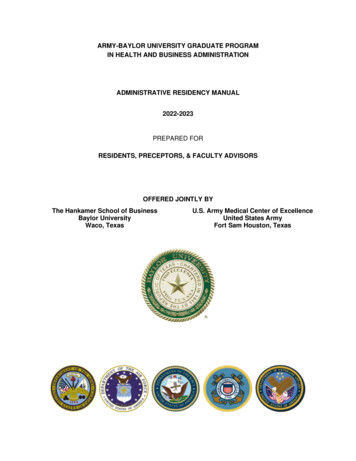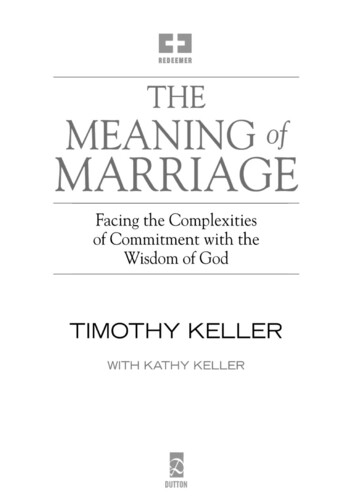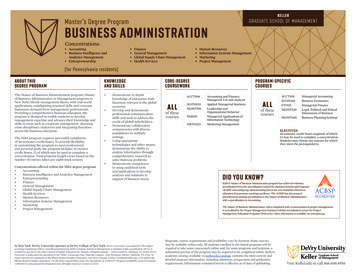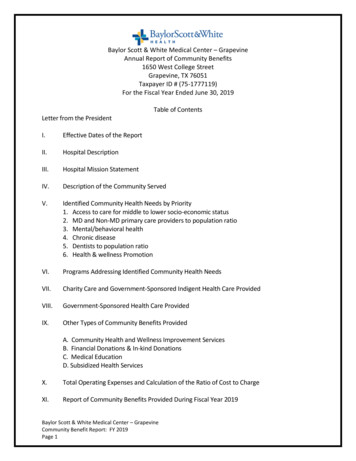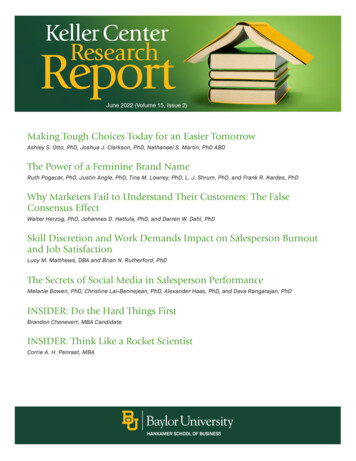
Transcription
Keller CenterResearchReportJune 2022 (Volume 15, Issue 2)Making Tough Choices Today for an Easier TomorrowAshley S. Otto, PhD, Joshua J. Clarkson, PhD, Nathanael S. Martin, PhD ABDThe Power of a Feminine Brand NameRuth Pogacar, PhD, Justin Angle, PhD, Tina M. Lowrey, PhD, L. J. Shrum, PhD, and Frank R. Kardes, PhDWhy Marketers Fail to Understand Their Customers: The FalseConsensus EffectWalter Herzog, PhD, Johannes D. Hattula, PhD, and Darren W. Dahl, PhDSkill Discretion and Work Demands Impact on Salesperson Burnoutand Job SatisfactionLucy M. Matthews, DBA and Brian N. Rutherford, PhDThe Secrets of Social Media in Salesperson PerformanceMelanie Bowen, PhD, Christine Lai-Bennejean, PhD, Alexander Haas, PhD, and Deva Rangarajan, PhDINSIDER: Do the Hard Things FirstBrandon Chenevert, MBA CandidateINSIDER: Think Like a Rocket ScientistCorrie A. H. Penraat, MBA
Keller Center Research ReportBaylor University, Keller Center for ResearchHankamer School of BusinessOne Bear Place #98007, Waco, TX 76798www.baylor.edu/kellercenter » Keller Center@baylor.eduKeller Center Research Report is a trademark owned by Baylor University. Baylor University. All rights reserved.Editorial StaffRandy Hacker, MBAExecutive DirectorMarjorie Cooper, PhDEditorAmanda Rodriguez, MBAAssociate EditoriKeller Center Research ReportJune 2022, Volume 15, Issue 2
Table of ContentsMaking Tough Choices Today for an Easier Tomorrow1Ashley S. Otto, PhD, Joshua J. Clarkson, PhD, Nathanael S. Martin, PhD ABDThe Power of a Feminine Brand Name4Ruth Pogacar, PhD, Justin Angle, PhD, Tina M. Lowrey, PhD, L. J. Shrum, PhD, andFrank R. Kardes, PhDWhy Marketers Fail to Understand Their Customers: The False Consensus Effect8Walter Herzog, PhD, Johannes D. Hattula, PhD, and Darren W. Dahl, PhDSkill Discretion and Work Demands Impact on Salesperson Burnout and JobSatisfaction13Lucy M. Matthews, DBA and Brian N. Rutherford, PhDThe Secrets of Social Media in Salesperson Performance18Melanie Bowen, PhD, Christine Lai-Bennejean, PhD, Alexander Haas, PhD, andDeva Rangarajan, PhDINSIDER: Do the Hard Things First23Brandon Chenevert, MBA CandidateINSIDER: Think Like a Rocket Scientist26Corrie A. H. Penraat, MBAiiKeller Center Research ReportJune 2022, Volume 15, Issue 2
Making Tough Choices Today for an Easier TomorrowAshley S. Otto, PhD, Joshua J. Clarkson, PhD, Nathanael S. Martin, PhD ABDConsumers make countless decisionsevery single day, from the moment theywake up to the moment they go to sleep.The sheer number of decisions to bemade forces individuals to determine theamount of effort they are willing to useto reach a decision. While somedecisions take little effort, others requiremore effort and thought put forth priorto reaching a decision. Specifically, ourresearch finds that there are twosituations, driven by a motivation toachieve cognitive closure, in which people will put more effort into the decision-making process:when similar decisions are expected to be made in the future and when credible options don’texist. Even though consumers typically want the quickest solution to a problem or situation, themotivation to achieve closure prompts one to put more effort in if it will simplify the process inthe future.Cognitive ClosureCognitive closure is the fundamental desire to arrive at a decision that reduces openness andachieves resolution. In other words, individuals high in need of cognitive closure do not likeuncertainty and ambiguity. These individuals make decisions that are traditionally associatedwith reduced effort investment. For some, the urge to achieve closure is so important that itcauses physiological distress, such as an increase in heart rate when making decisions. Whilethose seeking closure often jump at the first solution available, research shows that they willstrategically invest more effort into deciding when one of two scenarios arise.The first scenario shows that people will invest more effort when similar decisions are expectedto be made in the future. In our study, a group of participants was instructed to identify an itemon a menu that they would be interested in trying. First, respondents were randomly assigned toone of two conditions: they would make multiple decisions or they would only make onedecision. Simultaneously, they were told that they could choose between picking on their own(high effort option) or having the menu item randomly selected for them (low effort option).After their decision, the participants were asked to recall as many menu options as possible. Theresults showed that those seeking closure showed greater reliance on their own choice whenexpected to make multiple (vs. one) decisions and also had a greater recall of menu items (anindicator of greater decision effort).1Keller Center Research ReportJune 2022, Volume 15, Issue 2
Making Tough Choices Today for an Easier TomorrowThe second scenario occurs when people need to make a decision, but credible options do notreadily exist. Credible options may include an expert’s recommendation, a prior choice, or afavored option of others. Again, lacking a credible option prompts individuals seeking closure toinvest greater effort in decision making.Finally, in a repeat decision-making task, a third study demonstrates that upfront effort on aninitial decision did indeed lead people to invest less effort on subsequent, similar decisions. Byknowing and understanding the motivations and contexts under which individuals are likely toput forth decision effort, real estate professionals can boost their success with clients.Real Estate ImplicationsKnowing that those who are seeking cognitive closure are more willing to invest effort into thedecision-making process can be beneficial in the real estate industry. For example, an agent canmore easily gauge a client’s increased willingness to consider many options and features if theyknow the client is seeking cognitive closure. This knowledge may also help agents decipherwhich leads have already invested much effort into purchasing a property and which leads arecasually browsing.Additionally, an investor looking to purchase their first investment property may put more effortinto the decision-making process than an experienced investor and conduct a more extensivesearch. Knowing the criteria that lead to more effort put into the decision-making process canalso help with organization, time management, and more productively meeting clientexpectations. Some decisions can be harder than others, but knowing when to invest more effortin deciding can alleviate many headaches down the road as the client should be likely to revertback to their initial decision—such as sticking with their agent, current neighborhood, currentcity, etc.Recommended ReadingOtto, Ashley S., Joshua J. Clarkson, Nathanael S. Martin (2022), “Working Hard to Take theEasy Way Out: How the Need for Cognitive Closure Shapes Strategic Effort Investment to EaseFuture Decision Making,” Journal of Consumer Psychology, 32(2), 350-356.About the AuthorsAshley S. Otto, PhDAssociate Professor of Marketing, Baylor UniversityDr. Ashley Otto (PhD – University of Cincinnati) is a consumer psychologist who conductsresearch on decision making and self-control. Her research has been published in variousjournals, including the Proceedings of the National Academy of Sciences, Journal of Consumer2Keller Center Research ReportJune 2022, Volume 15, Issue 2
Making Tough Choices Today for an Easier TomorrowResearch, Journal of Academy of Marketing Science, and the Journal of Personality and SocialPsychology.Joshua J. Clarkson, PhDArthur Beerman Professor of Marketing, University of CincinnatiDr. Joshua Clarkson (PhD, Marketing – University of Florida and PhD, Social Psychology –Indiana University) is a consumer psychologist who specializes in the areas of persuasion, selfcontrol, and expertise. His research has been published in various journals, includingthe Proceedings of the National Academy of Sciences, the Journal of Consumer Research,the Journal of Marketing Research, and the Journal of Personality and Social Psychology, andhis findings have been featured in media outlets from business magazines and news articles topop-psychology books and edited academic volumes.Nathanael S. MartinPhD Candidate, University of CincinnatiNathanael Martin received his bachelor’s degree in Marketing at Clemson University and iscurrently pursuing his Doctor of Philosophy in Marketing at the University of Cincinnati.Nathanael is a consumer psychologist whose research focuses on information processing. Hiswork has been featured in edited academic books and presented at conferences such as theAssociation for Consumer Research and Society of Consumer Psychology.3Keller Center Research ReportJune 2022, Volume 15, Issue 2
The Power of a Feminine Brand NameRuth Pogacar, PhD, Justin Angle, PhD, Tina M. Lowrey, PhD, L. J. Shrum, PhD,and Frank R. Kardes, PhDA brand’s name is often the first interaction a brand or firm has with a consumer, and it has morepower than most individuals or companies realize. A brand’s name can influence consumers bysetting expectations and first impressions.1 Although this may seem insignificant, everyone hasexperienced the impact of an exceptional or subpar first impression. This research shows thatlinguistically feminine brand names enhance attitudes and choice, and are even correlated withbetter brand performance. This work contributes to the current body of knowledge by showinghow linguistically feminine names activate associations with “warmth” (good-natured sincerity)based on the stereotype content model, and how this affects brand outcomes.Stereotype Content ModelThis work draws on the stereotypecontent model to investigate perceptionsof brands with feminine associations.The stereotype content model is basedon the idea that people evaluate others(including brands) based on two socialperception criteria—warmth andcompetence—and these evaluationsshape people’s reactions bothemotionally and behaviorally.2 Previous studies have shown that the determination of warmth ismore important and is established before the determination of competence.3 Consumers are morelikely to favor (and thus, make more purchases and retain brand loyalty to) brands that havewarmer qualities. This research combines stereotype content model and psycholinguistics toshow that consumers perceive linguistically feminine names as warm, which increases positiveattitudes, choice, and is associated with better brand performance.Impact of Perceived Gender in Brand NamesFirst, it is important to understand the methods used to quantify brand name gender. Threefactors—length, ending sound, and stress—make a brand name masculine, neutral, or feminine.4Feminine names generally have more syllables and end with a vowel sound, while masculinenames are generally shorter and end with a consonant.5,6 Additionally, masculine names are morelikely to begin with a single stressed syllable (ROB-ert) while feminine names typically stressthe middle or later syllable (ro-BER-ta).7 Based on these three factors, Nestlé can be comparedwith Gap in terms of perceived gender, with Nestlé being linguistically feminine and Gaplinguistically masculine.4Keller Center Research ReportJune 2022, Volume 15, Issue 2
The Power of a Feminine Brand NameThis research showed that linguistically feminine brand names were correlated with positivebrand performance. After compiling an annual list of top brands and analyzing the ratio oflinguistically masculine and feminine brand names, linguistically feminine brands wereassociated with a higher rank on the list. It is important to note that this association showedcorrelation, but is not enough to demonstrate causality.The second study examined whether feminine brand names are preferred because they areperceived as warmer, i.e., whether warmth mediated the effect of brand name gender onconsumer attitudes. The results showed that feminine brand names are associated with warmthand positive attitudes, but these effects are again correlational and not enough to establishcausality. The next two experiments provided causal evidence for the feminine brand nameadvantage by having participants make consequential choices about how to spend time andmoney. Results showed that feminine brand names increased perceived warmth, and warmth inturn increased people’s choice of which media to watch and which products to take home.Boundary Conditions of the Feminine Brand Name AdvantageAfter demonstrating the positive impact of brand name femininity, this research further qualifiesthe impact. Specifically, the feminine brand name advantage is greater for certain productcategories but is neutralized for certain users.The fourth study examined the impact of the type of product category on the feminine brandname advantage—specifically, hedonic or utilitarian products. Hedonic products are fun andenjoyable, while utilitarian products are useful, functional, and practical.8 This experimentshowed that when a product was hedonic, the feminine brand names were favored even more,but when a product was utilitarian the masculine brand names were slightly favored.Additionally, when products were hedonic, feminine brand names increased warmth perceptions,which enhanced positive attitudes. Utilitarian products, on the other hand, did not receive a boostin attitudes due to perceived warmth.The last experiment examined the interaction between brand name gender and typical usergender on brand attitude and warmth. When the typical user was male (i.e., men’s sneakers),masculine and feminine brand names were equally well-liked. This is consistent with thesuccessful brand performance of both Converse (linguistically masculine name) and Nike(linguistically feminine name). In other words, the feminine brand name advantage wasneutralized when the typical user was male. When the typical user was female, the femininebrand name advantage remained intact.It is important to note that this study was conducted on English-speaking participants, therefore,findings may differ in different languages and different cultural contexts.5Keller Center Research ReportJune 2022, Volume 15, Issue 2
The Power of a Feminine Brand NameImplications for Managers and ConclusionsOverall, linguistically feminine brand names were seen to have a positive impact on historicalbrand performance, and on consumers’ attitudes via perceptions of warmth. Furthermore, thisfinding held in field tests with time and money consequences for the consumer. The femininebrand name advantage was increased for hedonic products, decreased for utilitarian products, andneutralized when the typical user was male.Our research highlights factors that should be taken into consideration when naming a real estatebrokerage or company. Do your clients value warmth, trustworthiness, and sincerity? If so, alinguistically feminine name—longer, ending in a vowel—may help communicate thosequalities. However, you might also consider the type of properties do you plan to list. Forexample, commercial properties might be considered utilitarian whereas clients probably valuehedonic qualities in a residential or vacation property. Each of these factors should informnaming decisions, which might lead to advantages in the real estate market.Recommended ReadingPogacar, Ruth, Justin Angle, Tina M. Lowrey, L. J. Shrum, and Frank R. Kardes (2021), “IsNestlé a Lady? The Feminine Brand Name Advantage,” Journal of Marketing, 85(6),101-117.References1. Aaker, David A. and Kevin L. Keller (1990), “Consumer Evaluations of Brand2.3.4.5.6.7.8.Extensions,” Journal of Marketing, 54(1), 27-41Fiske, Susan T., Amy J.C. Cuddy, and Peter Glick (2007), “Universal Dimensions ofSocial Perception: Warmth and Competence,” Trends in Cognitive Science, 11(2), 77-83.Cuddy, Amy J.C., Peter Glick, and Anna Beninger (2011), “The Dynamics of Warmthand Competence Judgments, and Their Out-comes in Organizations,” Research inOrganizational Behavior, 31, 73-98.Barry, Herbert Jr. and Aylene S. Harper (1995), “Increased Choice of Female PhoneticAttributes in First Names,” Sex Roles, 32(11/12), 809-819.Cutler, Anne, James McQueen, and Ken Robinson (1990), “Elizabeth and John: SoundPatterns of Men’s and Women’s Names,” Journal of Linguistics, 26(2), 471-482.Lieberson, Stanley and Eleanor O. Bell (1992), “Children’s First Names: An EmpiricalStudy of Social Taste,” American Journal of Sociology, 98(3), 511-554.Slater, Anne S. and Saul Feinman (1985), “Gender and the Phonology of North AmericanFirst Names,” Sex Roles, 13(7/8), 429-440.Adaval, Rashmi (2001), “Sometimes It Just Feels Right: The Differential Weighting ofAffect-Consistent and Affect-Inconsistent Product Information,” Journal of ConsumerResearch, 28(1), 1-17.6Keller Center Research ReportJune 2022, Volume 15, Issue 2
The Power of a Feminine Brand NameAbout the AuthorsRuth Pogacar, PhDAssistant Professor of Marketing, University of Calgary (Canada)Dr. Ruth Pogacar’s (PhD – University of Cincinnati) research focuses on the influence oflanguage on consumers, specifically brand name linguistics. She has published in the Journal ofMarketing, Journal of Consumer Psychology, Marketing Letters, and Behavior ResearchMethods.Justin Angle, PhDAssociate Professor of Marketing and Family Distinguished Faculty Fellow, University ofMontanaDr. Justin Angle’s (PhD – University of Washington) research focuses on how consumers utilizetheir consumer behaviors to display their identities. Dr. Angle has published in Journal ofMarketing, Journal of Consumer Research, and Journal Consumer Psychology. Outside of hisresearch, he also hosts a public radio program, A New Angle, and a podcast, Fireline.Tina M. Lowrey, PhDProfessor of Marketing, HEC Paris (France)Dr. Tina M. Lowrey’s (PhD – University of Illinois at Urbana-Champaign) research interestsinclude exploring brand symbolism specifically through children’s perspective and applyingpsycholinguistic theory to marketing communications. She has published research in Journal ofConsumer Research and Journal of Consumer Psychology, among others. Dr. Lowrey alsoserves on editorial review boards of the Journal of Consumer Psychology, Journal ofAdvertising, and Media Psychology.L. J. Shrum, PhDMarketing Department Head and Professor of Marketing, HEC Paris (France)Dr. L. J. Shrum’s (PhD – University of Illinois at Urbana-Champaign) research interests rangefrom media information’s impact on the creation of values, attitudes, and beliefs as well as therole of self in consumer judgement. His research has been published in the Journal of ConsumerResearch, Journal of Consumer Psychology, and Journal of Personality and Social Psychology.Frank R. Kardes, PhDProfessor of Marketing, University of CincinnatiDr. Frank R. Kardes’ (PhD – Indiana University) research, which focuses on consumer decisionmaking, persuasion and judgement, has been published in Psychology & Marketing, Journal ofMarketing, Marketing Letters, and Journal of Services Marketing. Dr. Kardes also serves on theeditorial boards for International Journal of Research in Marketing, Journal of ConsumerPsychology, and Journal of Consumer Research. In addition, he is a recipient of theDistinguished Scientific Achievement Award of the Society for Consumer Psychology.7Keller Center Research ReportJune 2022, Volume 15, Issue 2
Why Marketers Fail to Understand Their Customers:The False Consensus EffectWalter Herzog, PhD, Johannes D. Hattula, PhD, and Darren W. Dahl, PhDMarketing is all about understanding customer preferences and providing solutions that matchthese preferences. However, marketers’ perceptions of their target customers’ preferences can bebiased. We show that one of the most important biases in this category is the so-called falseconsensus effect (FCE)¾that is,marketers tend to project their personalpreferences onto customers.1 Notably,we find that even highly trainedmarketing professionals are susceptibleto the FCE and tend to confuse theirpersonal preferences with thepreferences of target customers. Overall,we conducted six studies with 714marketing executives to investigate theFCE in detail.The FCE from the Perspective of Marketing PractitionersWe first conducted two pilot studies to explore the role of the FCE from the perspective ofmarketing practitioners. One hundred marketing executives participated in our first pilot study.We found that 82.0% of the participating executives had an intuitive knowledge of the FCE. Ofthese participants, 92.7% witnessed that other marketers in their company had been recentlyaffected by the FCE, 86.6% admitted that they themselves had been recently affected by the FCE,and 79.3% indicated that marketers should try to avoid the FCE. In addition, 79.3% stated thatthey attempt to avoid the FCE when predicting customer preferences. Of these participants,75.4% indicated that they use a rather straightforward approach to avoid the FCE in practice—that is, they simply try to ignore or “suppress” their personal preferences when making customerpredictions.To provide further evidence for the managerial relevance of the FCE, we conducted a secondpilot study with 64 marketers. We asked the participants to rate the importance of ten skills ofmarketing managers, including the ability to separate personal and customer preferences (i.e., theability to avoid the FCE). Interestingly, we found that the ability to separate personal fromcustomer preferences was rated as the most important ability on the list (see Table 1 below).8Keller Center Research ReportJune 2022, Volume 15, Issue 2
Why Marketers Fail to Understand Their Customers: The False Consensus EffectTable 1Perceived Importance of Marketing Managers’ Skills (Pilot Study 2)Skills of Marketing ManagersTop-2-Box Score(percentage of marketing managers whoassigned an importance score of “1” or “2”)Ability to differentiate between their personal, subjective preferencesand the preferences of target customers81.25%Ability to pivot as new priorities emerge70.31%Creativity and innovation skills70.31%Natural leadership abilities56.25%Emotional intelligence57.81%Navigating ambiguity42.19%MarTech platform experience39.06%Financial acumen32.81%Curiosity42.19%Data science background9.38%Notes:N 64 marketing managers participated in the study. Participants were asked to rate the importance of ten skills of marketingmanagers (1 skill is very important, 9 skill is not important).Can Marketers Avoid the FCE?Overall, our pilot studies suggest that the FCE is an important bias in marketing practice and thatmarketers try to avoid it by attempting to ignore their personal preferences. A natural questionarising from these observations is whether this simple tactic is indeed an effective remedy for theFCE. We explored this question in four additional studies with 550 marketers.The studies consistently showed that the effectiveness of this tactic depends on marketers’ ownlevel of preference certainty—that is, the extent to which their personal preferences are clear andheld with conviction. The tactic was highly effective and reliably reduced the FCE for high levelsof preference certainty. However, for low certainty levels, the tactic backfired and increased theFCE. The latter finding is particularly important from a managerial point of view, becausemarketers frequently predict consumer reactions to novel stimuli (e.g., new products ortechnologies)—a situation known to result in lower levels of preference certainty. Hence, ourstudies suggest that the way marketers attempt to avoid the FCE in practice may frequentlybackfire and increase the FCE when predicting customer preferences. Figure 1 shows the resultsof study 1. The remaining studies replicated these results in a variety of decision-makingcontexts.19Keller Center Research ReportJune 2022, Volume 15, Issue 2
Why Marketers Fail to Understand Their Customers: The False Consensus EffectFigure 1Results of Study 1Notes:The figure shows whether attempts to suppress the FCE are effective. For low levels of preference certainty, attempts to suppressthe FCE backfire and increase the effect. For high levels of preference certainty, marketers are able to effectively suppress theFCE.Why do attempts to avoid the FCE backfire for low certainty levels? In this case, marketers’preferences are fuzzy and not well-defined. Further, it is impossible to make a clear distinctionbetween one’s personal and the target customer’s preferences if one’s personal preferences arenot clearly defined. According to psychologist Daniel Wegner, such attempts are, by definition,futile and will only increase decision makers’ focus on their personal preferences, which in turninflates the FCE.2,3 This is exactly what we observed in our studies.Overall, our studies indicate that marketers’ general susceptibility to the FCE can be greatlyreduced if they are advised to suppress their personal preferences for high, but not for low levelsof preference certainty. Marketers following this advice were also able to predict the preferencesof their target customers more accurately¾their prediction errors decreased by more than 50%.ImplicationsOur results have several implications for marketers and sales agents in the real estate business.First, they should keep in mind that the FCE may affect their perceptions in many contexts, suchas their perceptions of clients’ housing preferences or the market value of property4 (see Hattulaet al. 2015 for the impact of the FCE on pricing decisions). Second, real estate professionalsshould not think of the FCE as a useful heuristic. Our data clearly show that this tendency10Keller Center Research ReportJune 2022, Volume 15, Issue 2
Why Marketers Fail to Understand Their Customers: The False Consensus Effectreduces the accuracy of preference predictions. In other words, it is a “bias” that should beavoided. Third, based on their expert knowledge, real estate agents typically have clear personalhousing preferences and thus, our studies suggest that they can easily avoid the FCE (withoutrisking backfire effects). Hence, it is in the power of real estate professionals to steer clear of theFCE and avoid a self-referential perspective on their clients’ preferences.Finally, our research indicates that the FCE causes marketers to use customer data in anunsystematic way.1 Specifically, we find that marketers are more likely to rely on marketresearch on customer preferences if the results are in line with their personal preferences. Incontrast, they tend to ignore customer data that is not consistent with their personal preferences.In other words, marketers use customer data in an ‘egocentric’ way. This, in turn, has twoimplications: First, the current trend toward big (customer) data does not protect marketersagainst the FCE. Second, practitioners should keep in mind that the FCE can systematically biastheir interpretation and use of customer data.Recommended ReadingHerzog, Walter, Johannes D. Hattula, and Darren W. Dahl (2021), “Marketers Project TheirPersonal Preferences onto Consumers: Overcoming the Threat of Egocentric Decision Making,”Journal of Marketing Research, 58(3), 456-475. 1. Herzog, Walter, Johannes D. Hattula, and Darren W. Dahl (2021), “Marketers ProjectTheir Personal Preferences onto Consumers: Overcoming the Threat of EgocentricDecision Making,” Journal of Marketing Research, 58 (3), 456-475.https://doi.org/10.1177/00222437219983782. Wegner, Daniel M. (1994), “Ironic Processes of Mental Control,” Psychological Review,101(1), 34-52.3. Wegner, Daniel M. (2009), “How to Think, Say, or Do Precisely the Worst Thing for AnyOccasion,” Science, 325 (5936), 48-50.4. Hattula, Johannes D., Walter Herzog, Darren W. Dahl, and Sven Reinecke (2015),“Managerial Empathy Facilitates Egocentric Predictions of Consumer Preferences,”Journal of Marketing Research, 52(2), 235-252.About the AuthorsWalter Herzog, PhDProfessor of Marketing, WHU (Germany)Dr. Walter Herzog’s (PhD – University of St. Gallen) research interests lie at the intersection ofmanagement and consumer psychology. In particular, he is interested in social inferenceprocesses (e.g., how do executives predict consumer preferences and interpret market data?) andsocial influence strategies (e.g., how can executives shape the preferences of consumers and11Keller Center Research ReportJune 2022, Volume 15, Issue 2
Why Marketers Fail to Understand Their Customers: The False Consensus Effectemployees?). His research has appeared in various academic journals (e.g., Journal of MarketingResearch, Journal of Marketing) and has been featured in the business press (e.g., HarvardBusiness Review, Financial Times). Moreover, he teaches courses on marketing and behavioralresearch methods and he has received several awards for his courses at WHU.Johannes D. Hattula, PhDAssociate Professor of Marketing, Copenhagen Business School (Denmark)Dr. Johannes Hattula’s (PhD – University of St. Gallen) primary areas of research includemanagerial decision making, consumer behavior, and growth hacking strategies. His research hasappeared in leading academic journals, including the Journal of Marketing Research and theInternational Journal of Research in Marketing, and has been featured by business publicationssuch as Harvard Business Review, Financial Times, and the MSI Marketing Science Institute. Hiswork has been recognized by several awards and has been supported by various grants (e.g.,Swiss National Science Foundation) and companies.Darren W. Dahl, PhDInnovate BC Professor, University of British Columbia (Canada)Dr. Darren Dahl’s (PhD – University of British Columbia) current research interests are in theareas of new product design and development, creativity, consumer product adoption, the role ofsocial influence in consumer behavior, and understanding the role of self-conscious emotions inconsumptio
Keller Center ReportResearch Making Tough Choices Today for an Easier Tomorrow Ashley S. Otto, PhD, Joshua J. Clarkson, PhD, Nathanael S. Martin, PhD ABD The Power of a Feminine Brand Name Ruth Pogacar, PhD, Justin Angle, PhD, Tina M. Lowrey, PhD, L. J. Shrum, PhD, and Frank R. Kardes, PhD Why Marketers Fail to Understand Their Customers: The False




